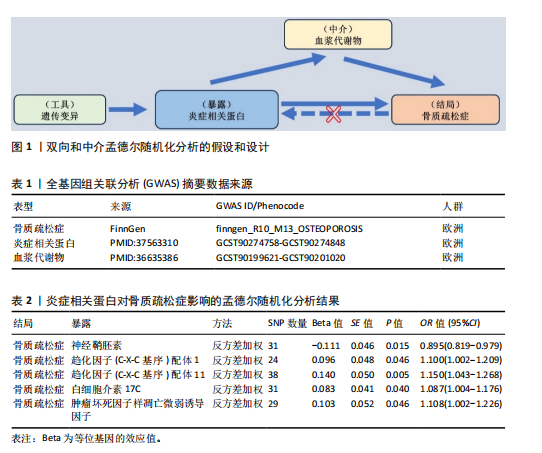[1] GOPINATH V. Osteoporosis. Med Clin N Am. 2023;107(2):213-225.
[2] MUNIYASAMY R, MANJUBALA I. Insights into the mechanism of osteoporosis and the available treatment options. Curr Pharm Biotechno. 2024;25(12):1538-1551.
[3] WANG Z, ZHANG X, CHENG X, et al. Inflammation produced by senescent osteocytes mediates age-related bone loss. Front Immunol. 2023;14:1114006.
[4] 陈帅,金杰,韩化伟,等.两样本孟德尔随机化分析循环炎症细胞因子与骨密度的因果关联[J].中国组织工程研究,2025, 29(8):1556-1564.
[5] XU J, YU L, LIU F, et al. The effect of cytokines on osteoblasts and osteoclasts in bone remodeling in osteoporosis: a review. Front Immunol. 2023;14:1222129.
[6] FANG CL, LIU B, WAN M. “Bone-SASP” in skeletal aging. Calcified Tissue Int. 2023;113(1):68-82.
[7] GUIJAS C, MONTENEGRO-BURKE JR, WARTH B, et al. Metabolomics activity screening for identifying metabolites that modulate phenotype. Nat Biotechnol. 2018;36(4):316-320.
[8] FAN J, JAHED V, KLAVINS K. Metabolomics in bone research. Metabolites. 2021;11(7):434.
[9] 张海永,黄景文,谢冰颖,等.骨疏康治疗去卵巢大鼠骨质疏松的腰椎代谢组学分析[J].中国组织工程研究,2022,26(32): 5185-5190.
[10] WANG J, WANG Y, ZENG Y, et al. Feature selection approaches identify potential plasma metabolites in postmenopausal osteoporosis patients. Metabolomics. 2022; 18(11):86.
[11] 廖欣宇,王福科,王国梁.骨组织工程支架的进展与挑战[J].中国组织工程研究, 2021,25(28):4553-4560.
[12] 董佳乐,魏远好,张洪武.基于知识图谱的骨缺损治疗可视化分析[J].中国组织工程研究,2022,26(18):2906-2913.
[13] 周宇翔,沈烈军,万诗雨,等.骨免疫调节特性骨组织工程支架在修复骨缺损中的应用和发展[J].中国组织工程研究, 2024,28(29):4734-4740.
[14] CHEN Z, XING F, ZHOU Y, et al. Integrated osteoimmunomodulatory strategies based on designing scaffold surface properties in bone regeneration. J Mater Chem B. 2023;11(29):6718-6745.
[15] HE J, GAI J. Genome-Wide association studies (GWAS). Methods Mol Biol. 2023; 2638:123-146.
[16] BIRNEY E. Mendelian Randomization. Cold Spring Harb Perspect Med. 2022;12(4): a041302.
[17] BOWDEN J, HOLMES MV. Meta-analysis and mendelian randomization: a review. Res Synth Methods. 2019;10(4):486-496.
[18] ZHAO JH, STACEY D, ERIKSSON N, et al. Genetics of circulating inflammatory proteins identifies drivers of immune-mediated disease risk and therapeutic targets. Nat Immunol. 2023;24(9):1540-1551.
[19] CHEN Y, LU T, PETTERSSON-KYMMER U, et al. Genomic atlas of the plasma metabolome prioritizes metabolites implicated in human diseases. Nat Genet. 2023;55(1):44-53.
[20] 于航天,赵妍,龚昂未,等.血脂与心力衰竭风险的因果关系及冠状动脉疾病的中介作用:一项孟德尔随机化研究[J].心血管病学进展,2024,45(1):91-96.
[21] BOWDEN J, DAVEY SG, BURGESS S. Mendelian randomization with invalid instruments: effect estimation and bias detection through Egger regression. Int J Epidemiol. 2015;44(2):512-525.
[22] PIERCE BL, BURGESS S. Efficient design for Mendelian randomization studies: subsample and 2-sample instrumental variable estimators. Am J Epidemiol. 2013; 178(7):1177-1184.
[23] BROADBENT JR, FOLEY CN, GRANT AJ, et al. MendelianRandomization v0.5.0: updates to an R package for performing Mendelian randomization analyses using summarized data. Wellcome Open Res. 2020;5:252.
[24] VERBANCK M, CHEN CY, NEALE B, et al. Detection of widespread horizontal pleiotropy in causal relationships inferred from Mendelian randomization between complex traits and diseases. Nat Genet. 2018;50(5):693-698.
[25] 高志杰,汪悦东,张志海.血液代谢物与骨质疏松症的孟德尔随机化研究[J].中国骨质疏松杂志,2024,30(8):1164-1168.
[26] RHODE SC, BEIER JP, RUHL T. Adipose tissue stem cells in peripheral nerve regeneration-In vitro and in vivo. J Neurosci Res. 2021; 99(2):545-560.
[27] HU Y, WANG L, ZHAO Z, et al. Cytokines CCL2 and CXCL1 may be potential novel predictors of early bone loss. Mol Med Rep.2020;22(6):4716-4724.
[28] 周子墨,柳达,陈森相,等.成骨分化内源性竞争性lncRNA-miRNA-mRNA网络与核心基因的研究[J].中国骨质疏松杂志, 2021,27(12):1792-1799.
[29] KIM HJ, PARK J, LEE SK, et al. Loss of RUNX3 expression promotes cancer-associated bone destruction by regulating CCL5, CCL19 and CXCL11 in non-small cell lung cancer. J Pathol. 2015;237(4):520-531.
[30] KORBECKI J, GASSOWSKA-DOBROWOLSKA M, WOJCIK J, et al. The importance of CXCL1 in physiology and noncancerous diseases of bone, bone marrow, muscle and the nervous system. Int J Mol Sci. 2022; 23(8):4205.
[31] CHOI M, PARK S, YI JK, et al. Overexpression of hepatic serum amyloid A1 in mice increases IL-17-producing innate immune cells and decreases bone density. J Biol Chem. 2021;296:100595.
[32] LI L, AMERI AH, WANG S, et al. EGR1 regulates angiogenic and osteoclastogenic factors in prostate cancer and promotes metastasis. Oncogene. 2019;38(35):6241-6255.
[33] 李克颖,杜娟.老年2型糖尿病合并骨质疏松患者血清TNF-α和TWEAK水平变化及临床意义[J].中国老年学杂志,2023, 43(15):3748-3751.
[34] 张小洁,袁芳,王藤颐,等.糖尿病肾脏病患者中医证型与血清维生素D和炎症因子的关系研究进展[J].中医药导报, 2024,30(3):132-134.
[35] TOUPCHIAN O, ABDOLLAHI S, SALEHI-ABARGOUEI A, et al. The effects of resveratrol supplementation on PPARalpha, p16, p53, p21 gene expressions, and sCD163/sTWEAK ratio in patients with type 2 diabetes mellitus: a double-blind controlled randomized trial. Phytother Res. 2021;35(6):3205-3213.
[36] YI KJ, KANG RM, ZHANG YY, et al. Causal relationship between circulating inflammatory factors and osteoporosis: a bidirectional Mendelian randomization study. Eur Rev Med Pharmacol Sci. 2024; 28(6):2237-2249.
[37] KONG SH, KIM JH, SHIN CS. Serum spermidine as a novel potential predictor for fragility fractures. J Clin Endocr Metab. 2021;106(2):582-591.
[38] WANG Y, DENG P, LIU Y, et al. Alpha-ketoglutarate ameliorates age-related osteoporosis via regulating histone methylations. Nat Commun. 2020;11(1): 5596.
[39] CAI W, ZHANG J, YU Y, et al. Mitochondrial transfer regulates cell fate through metabolic remodeling in osteoporosis. Adv Sci. 2023;10(4):e2204871.
[40] SHEN L, YU Y, KARNER CM. SLC38A2 provides proline and alanine to regulate postnatal bone mass accrual in mice. Front Physiol. 2022;13:992679.
[41] STANFORD KI, LYNES MD, TAKAHASHI H, et al. 12, 13-diHOME: an exercise-induced lipokine that increases skeletal muscle fatty acid uptake. Cell Metab. 2018;27(5):1111-1120.
[42] LEE S, KIM HS, KIM MJ, et al. Glutamine metabolite alpha-ketoglutarate acts as an epigenetic co-factor to interfere with osteoclast differentiation. Bone. 2021;145: 115836.
[43] CHENG C, XING Z, HU Q, et al. A bone-targeting near-infrared luminescence nanocarrier facilitates alpha-ketoglutarate efficacy enhancement for osteoporosis therapy. Acta Biomater. 2024;173:442-456.
[44] GUO Y, XIE C, LI X, et al. Succinate and its G-protein-coupled receptor stimulates osteoclastogenesis. Nat Commun. 2017;8: 15621.
[45] NISHIHARA S, IKEDA M, OZAWA H, et al. Role of cAMP in phenotypic changes of osteoblasts. Biochem Biophys Res Commun. 2018;495(1):941-946. |






